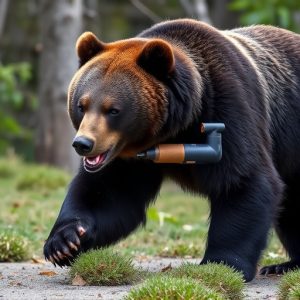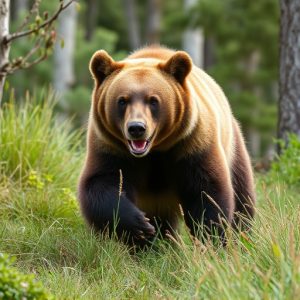Maximizing Bear Spray Efficacy: Range, Use, and Safety Tips
Bear spray, a potent deterrent using capsicum compounds from chili peppers, provides a vital safety…….
Bear spray, a potent deterrent using capsicum compounds from chili peppers, provides a vital safety zone of up to 30 feet (9 meters) against aggressive bears. Its effectiveness depends on proper application targeting the bear's face and close proximity, but wind conditions can significantly alter the actual range. Key safety tips include strategic use during encounters, regular testing, protecting the nozzle, understanding local regulations, and selecting products with advertised maximum distance coverage of 20-35 feet (6-10 meters) for optimal protection against bear threats.
Bear spray is a popular defense mechanism for hikers, campers, and outdoor enthusiasts navigating bear-inhabited areas. But does it really live up to the hype? This article delves into the science behind bear spray, exploring its effectiveness against charging bears and the factors influencing its range and efficacy. From understanding the chemistry to selecting the right product, we’ll guide you through everything you need to know about bear spray maximum distance coverage and safety tips for a secure outdoor experience.
- Understanding Bear Spray: How Does It Work?
- Factors Affecting Bear Spray Range and Efficacy
- Effective Use and Safety Tips for Bear Spray
- Comparing Bear Spray Maximum Distance Coverage: What to Look For
Understanding Bear Spray: How Does It Work?
Bear spray, also known as bear repellent, is a potent chemical substance designed to deter aggressive bears when facing a potential threat. Understanding how it works is crucial in knowing its effectiveness during encounters with these wild animals. When sprayed, the liquid or aerosol formula releases a range of capsicum compounds, commonly derived from chili peppers. These compounds irritate the eyes and respiratory system of the bear, causing them to momentarily stop and retreat.
The maximum distance coverage of bear spray varies among brands and factors like wind speed and direction. Typically, it can reach up to 30 feet (around 9 meters), providing a crucial buffer zone for users to escape or seek safety. However, direct bearing and close proximity are essential for optimal effectiveness. Despite its range, bear spray is most effective when used responsibly and in conjunction with other safety measures, such as making noise to deter bears before they become aggressive.
Factors Affecting Bear Spray Range and Efficacy
The effectiveness of bear spray in deterring a charging bear depends on several factors, including the bear spray maximum distance coverage and the user’s application technique. The range of bear spray varies among brands and can typically reach up to 30 feet (9 meters). However, factors like wind speed and direction can significantly impact the actual range experienced. A gentle breeze can reduce the effective reach by half, while a strong headwind might render it useless within seconds.
Proper application is also crucial for bear spray to be effective. The user should aim for the bear’s face, eyes, and nose, as these are sensitive areas. Bear spray works by irritating the bear’s respiratory system, temporarily disorienting and slowing it down. The distance at which the spray takes effect may not match the maximum coverage specified by manufacturers, especially if the bear is moving quickly or if the user is in an open area with poor air retention.
Effective Use and Safety Tips for Bear Spray
Bear spray is most effective when used correctly and at the right time during an encounter. It’s designed to create a barrier between you and the bear, giving you precious time to escape or play dead. For optimal results, aim for the bear’s face—eyes, nose, and mouth—from a distance of 20-30 feet (6-9 meters). This can temporarily stun the bear, allowing you to move away at a safe speed. Keep in mind that bear spray has a maximum distance coverage of around 30 feet, so ensuring a clear line of sight is crucial.
Safety tips are essential when carrying and using bear spray. Always keep it readily accessible, but avoid aiming or firing it unless necessary. Test the spray mechanism regularly to ensure it’s functioning properly. Keep your bear spray in its original packaging with the nozzle protected until you’re ready to use it. Additionally, familiarize yourself with local regulations regarding bear spray possession and usage, as these can vary depending on the region.
Comparing Bear Spray Maximum Distance Coverage: What to Look For
When considering bear spray for protection against charging bears, one of the critical factors to evaluate is the maximum distance coverage. This metric determines how far the spray can reach and effectively deter an approaching bear. It’s not just about having a powerful stream; it’s about ensuring the spray reaches the bear at close enough range to be effective. Look for products that advertise a substantial maximum distance, typically ranging from 20 to 35 feet (6 to 10 meters), as this will significantly increase your safety in the event of an encounter.
While some brands may claim longer distances, it’s essential to understand that factors like wind speed and direction, terrain, and the bear’s behavior can all impact the actual range of effectiveness. Therefore, always check product specifications carefully and consider the average maximum distance coverage as a reliable indicator of its ability to protect you during a potential bear encounter.
Bear spray is a valuable tool for personal safety in bear country, with its effectiveness proven against charging bears. Understanding how it works, the factors influencing its range and efficacy, and proper usage techniques are key to maximizing its potential. When choosing a bear spray, pay close attention to the maximum distance coverage to ensure you’re protected during outdoor adventures in bear-inhabited areas.


